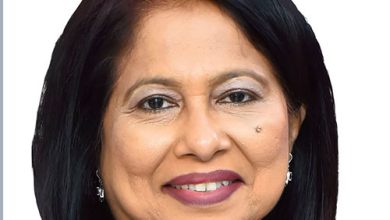WOMEN EMPOWERMENT
Compiled by Yamini Sequeira
GENDER EQUALITY APPRAISAL
Seroshi Nandasiri offers insights into fostering an inclusive ecosystem

Q: How have female professionals and entrepreneurs been impacted by the pandemic and economic crisis? And what are the main challenges that female business owners face at the grassroots, in your opinion?
A: In most crisis situations – be it a pandemic, political turmoil or an economic downturn – women are often the most impacted. The economic crisis severely affected women, particularly in the informal sector, which lacks social protection and safety nets.
The downturn led to widespread job losses in sectors that are heavily populated by women, such as textile and garment manufacturing, resulting in increased financial insecurity. Those who retained their jobs often face wage reductions and delays, further straining their household finances.
Many women who were running micro and small enterprises without substantial cash reserves or the ability to raise funds – and faced high capital and operational costs – have been compelled to shut down and resort to temporary work or seek employment as migrant workers.
This migration has brought additional social and cultural challenges for families, highlighting the need for targeted support and policies to protect and empower women.
Many women entrepreneurs lack access to essential business training and education, and this has created a knowledge gap that makes it difficult to manage and scale their businesses effectively.
The ILO reports that in Sri Lanka, only 32 percent of women have access to formal business training, which is crucial for entrepreneurial success. Moreover, the lack of a holistic and coordinated approach to make training and knowledge accessible leads to inefficiencies and redundancies.
Despite these challenges, many Sri Lankan women have shown remarkable resilience. Some adapted by pivoting business models, engaging in community support initiatives and leveraging online platforms to maintain their enterprises.
However, addressing the systemic issues that were highlighted and exacerbated by the pandemic is crucial for ensuring a more equitable recovery, and fostering long-term sustainability for women in the workforce.
Q: What solutions could help overcome the roadblocks female entrepreneurs face?
A: The role of the care economy and ecosystem will be pivotal in achieving holistic female empowerment.
Sri Lanka needs to address cultural barriers, enhance policy measures, and provide targeted support for women in leadership and entrepreneurship roles. Establishing mentorship programmes and networking opportunities can offer crucial guidance, support and connections.
Supportive policies that promote gender equality in business – including tax incentives for women led businesses and enforcing anti-discrimination laws – can create a more favourable environment.
Easier access to finance and financial services tailored to women entrepreneurs can help overcome initial capital barriers. Training programmes focussed on business skills, and financial and digital literacy, are essential to empower women to manage and grow their businesses. And facilitating better market access through platforms that connect women entrepreneurs with local and international markets can help expand their customer base.
By addressing these areas, a more inclusive and supportive ecosystem for women entrepreneurs in Sri Lanka can be created.
Q: How does Sri Lanka rank in female empowerment, in your assessment?
A: Sri Lanka has taken significant strides in female empowerment, particularly in education and healthcare. It boasted a female literacy rate of around 92 percent in 2021 with strong enrolments in secondary and tertiary education, and healthcare.
The country faces major challenges in achieving gender equality, especially in the workplace. Women represent 52 percent of the population and head a quarter of Sri Lanka’s five million households. However, their economic participation (32%) remains low with a youth unemployment rate of 36 percent.
Despite accounting for three-quarters of Sri Lanka’s enterprises, female ownership of SMEs is a mere 25 percent. In politics, female representation is starkly low with women holding only 5.3 percent of parliamentary seats, placing Sri Lanka 179th out of 189 countries.
With a Gender Inequality Index value of 0.383, Sri Lanka ranks at No. 92 among 170 countries. And the Global Gender Gap Report ranks the island at 110th out of 146 countries.
These rankings reflect major gender gaps in economic participation and political empowerment. Cultural attitudes, limited access to finance and societal norms further impede women entrepreneurs.
Q: Given the extent of brain drain, can more women be brought into the workplace to fill the gaps there are?
A: Integrating more women into the workforce can be a viable solution, provided systemic changes are implemented. By fostering an environment that values equitable responsibility sharing at home, women can balance economic contributions with familial roles more effectively.
In addition, establishing policies that support women’s entry and retention in the workforce – such as flexible working hours, accessible childcare and targeted skill development programmes – can bridge the gap.
This not only addresses the immediate need for skilled labour due to brain drain but also promotes a more inclusive and resilient economy. In the long run, it will ensure that social costs are balanced with economic gains.





